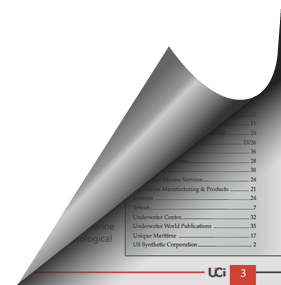
The Magazine for Underwater Professionals
![]() Oct/Nov 2018
Oct/Nov 2018
OPERATIONS
Fish stock monitoring
Cefas scientists complete six-week, 1700-kilometre autonomous fisheries acoustics mission
Collecting data and mapping fish stocks can be very challenging especially if you’re trying to accomplish this in the turbulent North Sea. With strong currents, crowded with hazards, such as sandbanks, merchant shipping and fishing vessels, collecting high quality data is daunting. This is especially true when you’re collecting data on some of the smallest marine life in the ocean (zooplankton and fish).
Overcoming this challenge, a state-of-the-art technique for mapping and counting schools of fish has been successfully tested on an autonomous marine platform. By complementing existing methods, the new development could eventually lead to cost savings, increased efficiencies, and higher resolution data.
Cefas (Centre for Environment, Fisheries and Aquaculture Science, UK) and Liquid Robotics, USA, deployed, tested and recovered a remotely piloted Wave Glider, which was adapted to allow scientists to collect high quality broadband fisheries acoustics data.
As part of a multi-vehicle mission under the UK NERC/Defra funded AlterEco project, the Wave Glider called Lyra was deployed in the central North Sea about 270 kilometres north-east of Newcastle-upon-Tyne, UK, by RV Cefas Endeavour. She spent 41 days at sea, repeatedly covering a 64-kilometre-long transect along which valuable data were collected under different conditions, before finally being recovered by RV Cefas Endeavour, 20 kilometres off Lowestoft. While deployed, the Wave Glider was remotely piloted 24/7 by the Liquid Robotics’ operations team from their California, USA, headquarters in Silicon Valley almost 9000 kilometres away and covered more than 1700 kilometres at sea.
LEARN
For this mission, Cefas’s Lyra was fitted with the new Kongsberg Maritime, Norway, Simrad EK80 broadband echosounder with two transducers (200kHz and 70kHz), utilising a version of the electronics that has been specifically designed for autonomous surface vehicles called the WBT Mini. The system was self-contained with its own dedicated battery and used in standalone mode. Lyra collected acoustic data continuously for 23 days on the organisms in the water-column at very high resolution, which scientists are now using to learn more about zooplankton and fish populations around the UK.
Traditionally, such techniques have required the use of survey vessels, but Cefas technologists have integrated equipment on to the Wave Glider to explore the possibility of using new platforms to complement ship-based monitoring. In the long-run this could offer value for money and more comprehensive measurements to understand the marine environment.
As with previous missions, Lyra was also fitted with a Cefas ESM2 data logger, which collected information on the physical properties of the sea surface including salinity, temperature, oxygen, fluorescence, turbidity and solar irradiance data at five-minute intervals. These data will be used to study the oceanographic features of this dynamic area. Lyra was also fitted with a meteorological sensor recording wind speed and direction, air temperature and barometric pressure, which will be used to estimate sea state and thus the performance of the acoustic system under different weather conditions.
Preliminary results suggest that evidence has been captured of diurnal (day-night) vertical migrations of zooplankton and other organisms in the water column, as well as schools of fish. At the start of the deployment, net samples of zooplankton were collected aboard the RV Cefas Endeavour, which will be used to help identify the organisms that are acoustically detected.
COLLECT
Dr David Pearce, Cefas head of Profession, Marine Observations Systems and in command of the mission, says: “When Cefas purchased Lyra, the fisheries acoustics application was the one that stood out as very technically challenging but with potential to collect important data in a cost-effective way.
“This very successful mission outcome was possible due to development work carried out by a multi-disciplinary team of experts at Cefas including scientists, mechanical and electronic engineers, software developers and technicians.
“These autonomous vehicles could eventually take over elements of ship-based monitoring of the fish and zooplankton community by being able to identify these components of the food chain from the acoustic data alone and thus saving money by reducing the durations of ship-intensive surveys.”
Dr Jeroen van der Kooij, Cefas pelagic fisheries scientist, adds: “After seeing the preliminary data we collected, I am extremely excited about the future for autonomous vehicles, such as the Wave Glider, for providing valuable zooplankton and fisheries data to help meet our future scientific and monitoring requirements.”


